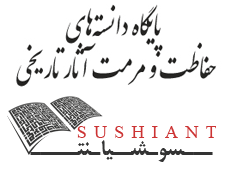فرزانه ریسمانچیان
بررسی و تحقیق فرسودگی شیشههای تاریخی
پایاننامهی کارشناسی ارشد،
پردیس اصفهان،
دانشگاه هنر، 1376
استاد راهنما: ابوالفضل سمنانی
استاد مشاور: حسین آقاجانی
چکیده:
شیشهگری هنری است با قدمت دیرینه و از آنجا که آثار شیشهای بهجا مانده نمودی از خلاقیت هنرمندان و فرهنگ و تمدن دوران مختلف است، حفظ و نگهداری آنها به عنوان بخشی از میراث فرهنگی حائز اهمیت بسیاری است، در این راستا در قسمت تئوری رسالهی حاضر پس از مروری تاریخی، ماهیت و تکنولوژی ساخت شیشه تشریح و بدنبال آن فرآیندهای تخریبی مربوطه مورد بحث قرار گرفته و همچنین ویژگیهای مطلوب مواد مصرفی جهت حفاظت و مرمت شیشه بررسی شده است. در قسمت عملی با بهکارگیری تکنیکهای میکروسکوپی الکترونی (SEM) اسپکتروسکوپی جذب اتمی (AAS) ، اسپکتروسکوپی نشر اتمی (AES)، فلورسانس پرتوهای ایکس (XRF) و بهرهگیری از مطالعات تئوریک ۱۸ نمونهی تاریخی آسیبشناسی و مکانیسم تخریب آنها مشخص شده است. سپس با توجه به نتایج حاصله پیشنهادات مرمتی و حفاظتی مناسبی ارائه گردیده است. در ضمیمهی ۱ به معرفی تعدادی از روشهای آنالیز ساختاری و ساختمانی شیشه پرداخته شده و همچنین در ضمیمهی ۲ روش غیر تخریبی کاربرد پرتوهای UV در شناسائی شیشههای سربی تجربه شده است.
Abstract: Glass manufacture is an old and ancient art. As the glass pieces left, are the reminder of the artists creativity and culture of the people from different civilization and era, their restoration as a part of our cultural heritage is very important. In the theoretical part of this theses after a passage about history of these materials, the essence of technology and fabrication of glassware is described and then the process of damage is discussed, also the desirable specification of materials for restoration and conservation of glass are studied. In the practical part, by the use of Electronic Microscopic Scan technique (SEM), Atomic Absorption Spectroscopy (AAS), Atomic Emission Spectra. Scopy (AES) and X Ray Florescence (XRF) and considering the use of theoretical studies, 18 historical samples of identified damages and the mechanism of their damages are distinguished, and then proposals for restoration are presented. In the appendix number one, analytical methods of fabrication and structure of glass ware are introduced, and in the appendix number two, application of nondestructive methods of UV rays in recognition of lead glass ware are experienced.
